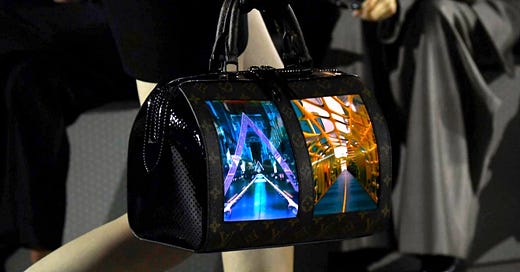Four key motivations behind wearable technology
Our second deep dive into the past, present, and future of wearable technologies.
Welcome to the Unfolding NEW PATTERNS. In my latest podcast, Fashion Knowledge, I discuss smart wearables and the future of interactive fashion with Ivan Poupyrev. Find out more on Instagram.
In our previous deep dive, we delved into the history and functionalities of wearable technologies, highlighting their intimate connection to our bodies, whether enhancing or measuring our physical capabilities. This edition turns to the psychology of wearable technology, examining how it aligns with existing needs and, perhaps might foster the emergence of new ones.
Does wearable technology fulfill existing needs, or does it create new ones? Do we truly need these devices, or are we just chasing the thrill of novelty? What do they bring to our, already very fast-paced and digitalized, lives?
To grasp the function of wearable technology and, more specifically, smart clothing, I investigated 40 different projects. This exploration made it evident that their functions fall into four distinct categories: aesthetics, efficiency, optimization, and well-being.
1. AESTHETICS
Firstly, aesthetics integrate technology with fashion, creating pieces that offer more than utility — they bring a bit of magic. Take, for instance, the Louis Vuitton bag from 2019, designed by Nicolas Ghesquière, covered with flexible OLED screens, exemplifying how technology amplifies beauty through innovation and newness. This is a function we can’t dismiss in the world of design - pleasure is its fundamental part.

2. EFFICIENCY
While we take pleasure in beauty and joy, there's an equal appreciation for the seamless and effortless — the qualities now synonymous with great design. This mindset, echoing the maxim "Good design is invisible," is championing efficiency, time-saving and the ease it brings to our cognition that we've come to value highly. It's a trend corresponding with what we might call the 'Psychological Economy' — the concept of reducing mental, physical, and temporal costs to enhance well-being and satisfaction, by conserving energy and maximizing rewards. Fashion and technology have responded to our frictionless and no-time-wasting world with innovations like Nike's self-lacing shoe, which asks the question: why spend time tying your shoes when you don't have to?

Keep reading with a 7-day free trial
Subscribe to Unfolding NEW PATTERNS to keep reading this post and get 7 days of free access to the full post archives.





